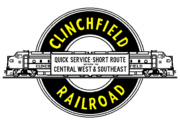- Size: 10′ x 12′
- Scale: N
- Minimum Radius: 18″
- Minimum Aisle Width: 22″
- Designed by Dan Bourque
 St Paul, Virginia, was a unique piece of railroad. The N&W, travelling from East to West, and the Clinchfield, travelling from North to South, intersect and run parallel through the town with wyes at either end. The CRR and N&W interchanged at Boody, and there were a few small industries in town. St Paul offers a lot of variety in operation depending on the time period modeled. Up to the 60s, the N&W and CRR were the only game in town–each going about its own business. Beginning in 1973 until 1986, the L&N was exercising trackage rights over the N&W from Norton to interchange with the CRR at Castle Yard (a glorified passing siding). L&N crews would bring a loaded coal train down the wye to the west of town, drop off the hoppers at Castle, and then layover the engines and caboose at a spur in town until an empty train was dropped-off by the CRR. After 1986, both CSX and Norfolk Southern trains would travel down the ex-Clinchfield towards destinations in the South due to a cooperative trackage agreement between the two roads. Some N&W trains still went to Norton, but the majority took the CRR shortcut.
St Paul, Virginia, was a unique piece of railroad. The N&W, travelling from East to West, and the Clinchfield, travelling from North to South, intersect and run parallel through the town with wyes at either end. The CRR and N&W interchanged at Boody, and there were a few small industries in town. St Paul offers a lot of variety in operation depending on the time period modeled. Up to the 60s, the N&W and CRR were the only game in town–each going about its own business. Beginning in 1973 until 1986, the L&N was exercising trackage rights over the N&W from Norton to interchange with the CRR at Castle Yard (a glorified passing siding). L&N crews would bring a loaded coal train down the wye to the west of town, drop off the hoppers at Castle, and then layover the engines and caboose at a spur in town until an empty train was dropped-off by the CRR. After 1986, both CSX and Norfolk Southern trains would travel down the ex-Clinchfield towards destinations in the South due to a cooperative trackage agreement between the two roads. Some N&W trains still went to Norton, but the majority took the CRR shortcut.
The Layout
This layout replaces a similar HO-scale plan which proved to be unworkable. In the first plan, there wasn’t enough care given to the elevations leading to impossible grades which have been remedied in this N-scale version. The layout focus is the two wyes that made St Paul unique. Along with the wyes, the town of St Paul and the small yards at Boody (N&W) and Castle (CRR) are also modeled. One of the steel trestles on the N&W is modeled, though with only 3 inches of vertical separation from the tracks below, it’s not a very high trestle.
The staging level for this layout is complex. Staging forms a continuous loop for both the Clinchfield and N&W mainlines which was tricky due to the crossover on the main level. There is a double-ended staging yard for each railroad, though the lion’s share of the tracks are reserved for the CRR which had more variety in its through trains thanks to its connection with the C&O to the north. Each railroad also has a set of stub staging tracks for trains that only appear once in an ops session.
The aisles on this layout are narrow to cram everything into the tight space, but this could be alleviated somewhat if 15″ radius were acceptable to the builder. A DCC system with walk-around throttles and automatic polarity reversers for the three wyes would simplify wiring and operations.
Operations are designed for 1-2 people (no room for more). With two, one could run the Clinchfield and the other the N&W (or N&W and L&N in the ’70s and ’80s). Clinchfield trains would consist primarily of through freights. Traffic would be mostly CRR and C&O coal heading south and empty hoppers heading north (all the Clinchfield’s coal loaders were between St Paul and Elkhorn City, KY to the north), though a couple of merchandise freights each direction would be in order to simulate the C&O through traffic. Clinchfield turns from Dante staging would also be needed to work the interchange at Boody bringing coal bound for prep plants on the N&W’s Hurricane Branch to the east and picking up coal dropped off by the N&W turns from Norton to the west. Finally, in a 1973-1986 era, a couple of trains from Erwin would be needed to work the interchange with the L&N at Castle delivering empties and taking L&N loads south.
N&W operations would consist of a few coal trains daily heading from Norton to the west to Bluefield and a similar number of empty trains heading back. There would also be a couple of “Boody Turns” daily to move CRR-bound coal from Norton to the interchange at Boody as well as trains from the east to take the hoppers bound for the Hurricane Branch’s prep plants. Finally, in a 1973-1986 era, A few L&N trains would run over the N&W from Norton and take the wye to Castle Yard to dump off their loads and return with empties–this power would often sit on the spur to the aisle side of the wye to wait for the CRR to bring in the empties.
Things I Like About this Plan:
- Lots of interesting operation in a small space
- Three railroads
- Variety of traffic
Things I Don’t Like About this Plan:
- Duck-under
- Train length very compressed
- Limited staging
- Complicated staging level
- Two helixes on a small layout
Related Products:




